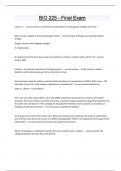Samenvatting
Samenvatting deeltentamen 1 (H1 tm 7) biopsychologie + oefenvragen
- Instelling
- Rijksuniversiteit Groningen (RuG)
Dit is een samenvatting van alle hoofdstukken die geleerd moeten worden voor het eerste deeltentamen van biopsychologie (H1tm7). Deze samenvatting bevat ook veel plaatjes die de tekst ondersteunen. Dit document bevat ook oefenvragen
[Meer zien]













